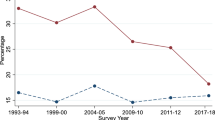Abstract
Using hourly and weekly wages from the Canadian Labour Force Survey from 2000 until 2018, workers were separated into full-time and part-time and the following striking observation was documented. The overall gender wage gap is larger than either the full-time pay gap or the part-time pay gap, even after controlling for detailed personal and job characteristics. This result is a consequence of two findings: (i) part-time wages are lower than full-time wages, and (ii) the majority of part-time workers are women. In aggregation, this brings down the average female wage, leading to a larger aggregate gender wage gap. This was further linked to a differential selection by gender into full-time and part-time work, with women of higher earnings potential being overrepresented in the pool of part-time workers, resulting in no gender pay gap in the part-time worker category. Policies targeted at encouraging full-time employment for women should therefore reduce the gender wage gap.



Similar content being viewed by others
Notes
Statistics Canada’s definition of part-time as less than 30 hours of work per week. At the suggestion of a referee, sensitivity analyse using 35 hours per week as the part-time cut-off were conducted.
Higher education can result in increased female labour force participation for the relatively more educated groups, affecting positively the gender wage gap (Olivetti and Petrongolo, 2008). The selection out-of-the-labour-force of lower educated women can explain differences in the magnitude of the gender wage gap across European countries.
An even larger differential between the overall gender gap and the FT and PT gaps can be documented on annual incomes using census data. The census analysis is not reported here because the frequency of data is different, and the LFS has a richer set of characteristics that can be used in the analysis.
With the addition of workers with 30 to 35 hours per week of work, the part-time group becomes slightly larger for both men and women. The group working 30 to 35 hours has average earnings above the group working less than 30 hours, and below those of the group working more than 35 hours. As such, when the group working between 30 to 35 hours is moved from the full-time definition to the part-time definition, mean wages become higher in the new part-time group which gains higher earners, and they also become higher in the new full-time group which loses lower earners. We thank an anonymous referee for suggesting this sensitivity analysis.
References
Antonie, L., D'Angelo, A., Grewal, G., & Plesca, M. (2015). Analyzing the gender wage gap in Ontario's public sector. In 2015 IEEE 14th International Conference on Machine Learning and Applications (ICMLA) (pp. 465–470). IEEE. https://ieeexplore.ieee.org/document/7424359 accessed 6 June, 2020.
Baker, M., & Drolet, M. (2010). A new view of the male/female pay gap. Canadian Public Policy, 36(4), 429–464.
Baker, M., & Fortin, N. M. (2001). Occupational gender composition and wages in Canada, 1987–1988. Canadian Journal of Economics/Revue canadienne d'économique, 34(2), 345–376.
Blau, F. D., & Kahn, L. M. (2017). The gender wage gap: Extent, trends, and explanations. Journal of Economic Literature, 55(3), 789–865.
Boudarbat, B., & Connolly, M. (2013). The gender wage gap among recent post-secondary graduates in Canada: A distributional approach. Canadian Journal of Economics/Revue canadienne d'économique, 46(3), 1037–1065.
Dickens, W. T., & Lang, K. (1993). Labor market segmentation theory: Reconsidering the evidence. In labor economics: Problems in analyzing labor markets (pp. 141–180). Springer, Dordrecht.
Erosa, A., Fuster, L., Kambourov, G., & Rogerson, R. (2017). Hours, occupations, and gender differences in labor market outcomes. NBER Working Paper, (w23636). https://www.nber.org/papers/w23636 accessed 19 December 2019.
Fortin, N. M., & Schirle, T. (2006). Gender dimensions of changes in earnings inequality in Canada. Dimensions of inequality in Canada,Canada, Vol. 1 of 2. Ed. John Kesselman and David Green. Vancouver, BC: University of British Columbia Press: 307-346.
Ghilarducci, T., & Lee, M. (2005). Female dual labour markets and employee benefits. Scottish Journal of Political Economy, 52(1), 18–37.
Goldin, C. (2014). A grand gender convergence: Its last chapter. American Economic Review, 104(4), 1091–1119.
Goldin, C., & Katz, L. F. (2016). A most egalitarian profession: Pharmacy and the evolution of a family-friendly occupation. Journal of Labor Economics, 34(3), 705–746.
Hotz, V. J., Johansson, P., & Karimi, A. (2017). Parenthood, family friendly workplaces, and the gender gaps in early work careers (no. w24173). National Bureau of Economic Research. https://www.nber.org/papers/w24173.pdf accessed 8 December 2019.
Juhn, C., & McCue, K. (2017). Specialization then and now: Marriage, children, and the gender earnings gap across cohorts. Journal of Economic Perspectives, 31(1), 183–204.
Olivetti, C., & Petrongolo, B. (2008). Unequal pay or unequal employment? A cross-country analysis of gender gaps. Journal of Labor Economics, 26(4), 621–654.
Statistics Canada. (2019). Labour Force Survey 2000 to 2018 (2019). https://www150.statcan.gc.ca/n1/en/catalogue/71M0001X Data available from http://odesi2.scholarsportal.info/webview/ Accessed 11 December 2019.
Author information
Authors and Affiliations
Corresponding author
Additional information
Publisher’s Note
Springer Nature remains neutral with regard to jurisdictional claims in published maps and institutional affiliations.
Rights and permissions
About this article
Cite this article
Antonie, L., Gatto, L. & Plesca, M. Full-Time and Part-Time Work and the Gender Wage Gap. Atl Econ J 48, 313–326 (2020). https://doi.org/10.1007/s11293-020-09677-z
Published:
Issue Date:
DOI: https://doi.org/10.1007/s11293-020-09677-z




